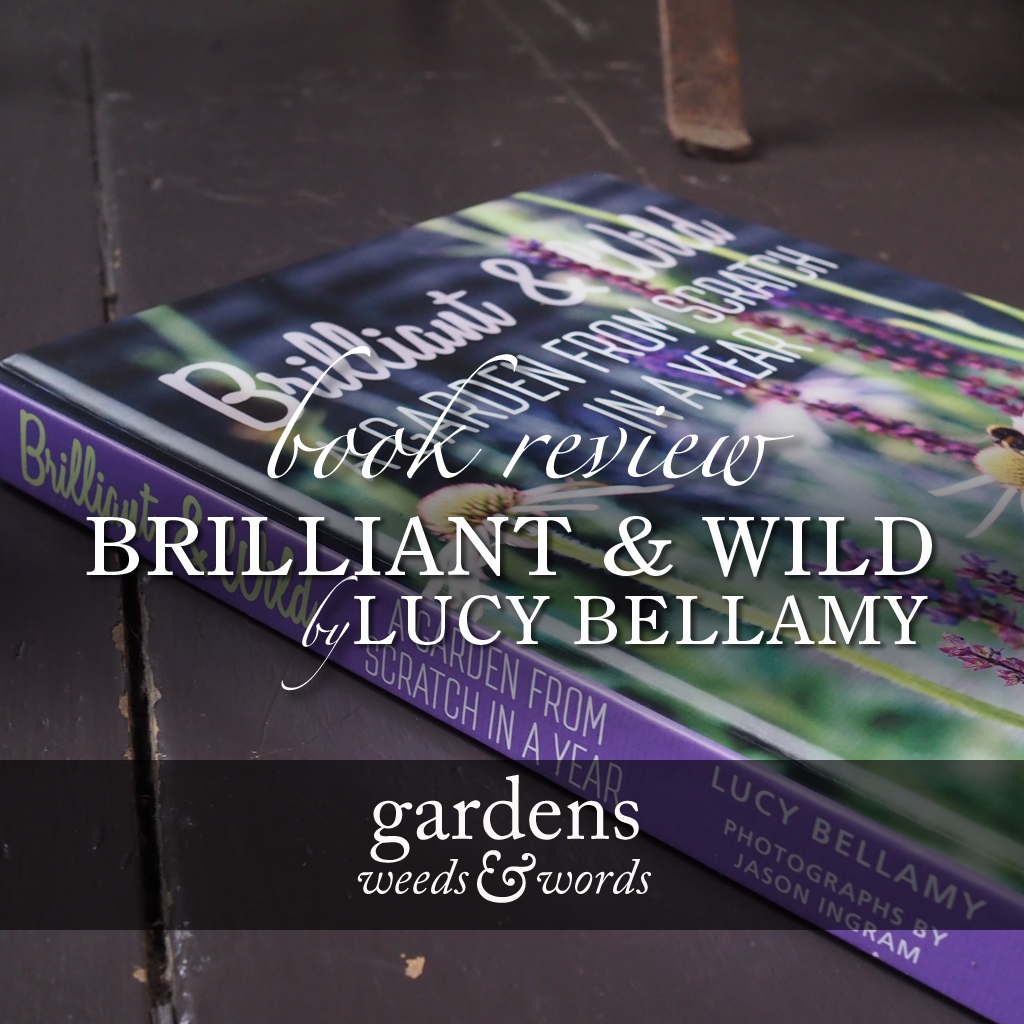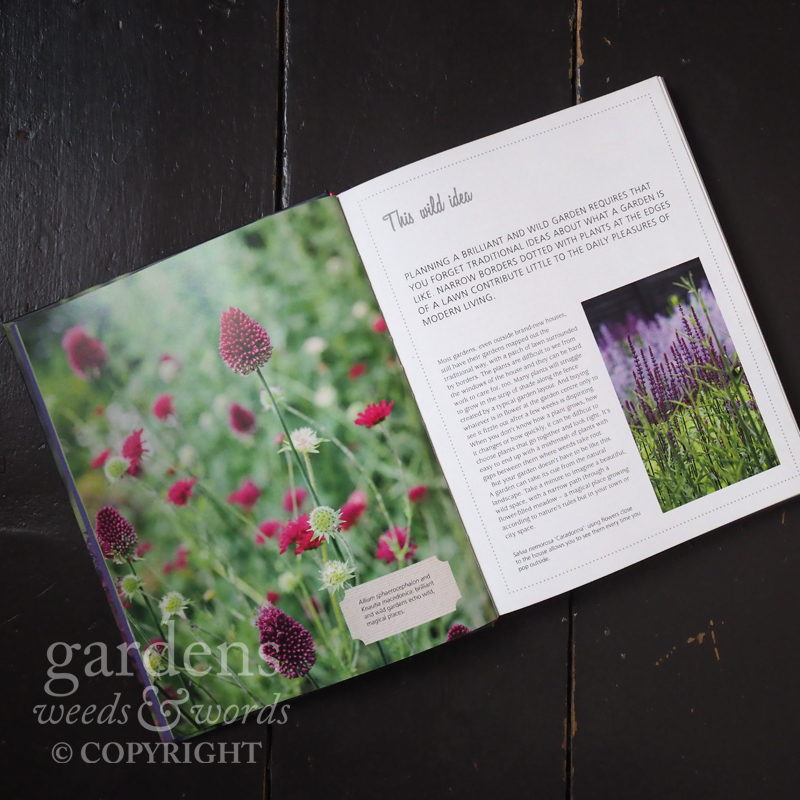Book review
This post contains affiliate links
Published by Pimpernel Press, Brilliant & Wild is a beautifully produced book with text by Lucy Bellamy, garden journalist and editor of Gardens Illustrated magazine, with mouthwatering photographs of gardens and plants supplied by Jason Ingram.
Visually, it’s a very pleasing object – it’s a medium sized format (24cm x 19cm x 1.8cm thick) that sits perfectly in the hands, unencumbered by dust jacket, the full bleed photo of summer perennials on the front cover board setting the scene for the kind of photography to be found within – mostly plant portraits taken with a shallow depth of field, with some portraits of Lucy in the garden. It’s the kind of dreamy, detail-oriented photography where you find yourself directed to observe aspects of a plant you might miss when presented with an entire border – the hairs on the stems of an echinacea, the delicate, golden filigree around the central boss of a helenium. There are also more illustrative shots to amplify the step-by-step sections within the text, which fulfil their purpose with aplomb, but it’s the pages of sparkling plant porn distributed generously throughout the extent which will do so much to keep the casual browser engaged.
Which is just as well, for beyond an insouciant perusal there’s a message worth hearing, and one which, from my own experience, will fall upon the fertile ground that many a new home or allotment owner will have found themselves custodian of. And the first paragraph of the introduction pithily encapsulates the proposal:
“With just a few tools and a back-of-an-envelope plan, it is easy to grow a blooming, bee-filled garden from scratch in a single year – a space wild in character that happily knits together in a matter of months, brimming with bugs, birds and butterflies, somewhere that echoes other natural, beautiful places in an incredible sparkling whoosh, wilder, greener and right outside the back door”.
This introduction reads like a manifesto, the continual repetition of “the brilliant and wild garden” indicating that this is more than just a catchy title for another gardening book. This is about putting an emphasis on the plants, rather than hard landscaping, about simple, unfussy flowers with a wild “character”, about food for birds and bees and butterflies and a community of plants that will work just as well in an urban space as in the countryside. It’s about seasonality, and change, and rhythm, and never standing still.
Since so much is made of the phrase, I wanted to take few moments to examine the concept of the “brilliant and wild garden” from the point of view of a blog which deals, from time to time, with the wonder of weeds. It’s my firm contention that anyone can have a wild garden billowing romantically beyond the back door, absolutely pulsating with bees and butterflies and all manner of wildlife, and the way to achieve this is by doing precisely nothing. Except, perhaps, running the mower to make a path down the middle (on as winding a route as the fancy takes you), so you can get through the towering grasses and perennials upon either side. The downside is, your neighbours will hate you, because the little patch of wildflower-filled wilderness you’ve allowed to grow will appear to them nothing more than a disgraceful patch of weeds. We tend to like a little romance with our wilderness, a little less yellow, a bit of artfully disguised discipline undergirding the apparent chaos. So much for the wild garden. But this, I think, is where the “brilliant” bit comes in – a garden that gives the feeling of wild, untamed nature, but which has sufficient colour, artfulness and order to avoid offending the neighbours. Brilliant, and wild. We’ve been talking about this since William Robinson, but Lucy Bellamy’s book holds a plan for the typical 21st century garden.
As to the practicalities of establishing such a garden, whether you consider natural flora to be wildflowers or weeds, they will form the competition for your new plantings, and the odds are stacked significantly in their favour. The author has hit upon one of the best ways of achieving a season or two’s grace from the ravages of Mother Nature, which is to carve out portions of an established lawn to create the borders and beds – removing the vast majority of the established plant community with the turves (which can then be left somewhere to quietly decompose into wonderful, loamy compost) and allowing her carefully selected tapestry of perennials time to knit together.
There are excellent step-by-steps instructions as to how this was achieved, but even better would have been to have made this underlying strategy more explicit in the text, as not all garden situations are quite so tolerant and forgiving when new plant communities are introduced – particularly the kind of summer-flowering perennials recommended here which at the time of writing are barely shaking off their winter’s slumber and are yet to produce a leaf, while creeping buttercup, hairy bittercress and rosebay willow herb are already staking their claims upon the spaces between (let’s not even mention couch grass. Actually, couch grass does get a mention here, but it’s rather fleeting). Appropriate site preparation is key to all new planting schemes, and the editors could well have made the (admittedly painful) decision to sacrifice one or two of Jason Ingram’s gorgeous full page photographs to ensure this information was treated in a little more detail. It’s my only real niggle with book, and it’s all the more frustrating in a title so otherwise deserving of merit. I shall pin my hopes on this getting tweaked in a reprint – publishers please note.
The chapter on plants is a cornucopia of floral delights, a sweetshop where all the tempting wares are laid out invitingly before you. There’s nothing wild or whacky – that’s not the point of the book – just tried and tested, reliable varieties which have earned their place for their combination of beauty, an easy-going nature, and their attractiveness to pollinators. Each plant gets at least one good mugshot (some have more wafty portrait type shots in addition), a fact box including details such as common name, botanical name, botanical family, height, reasons to grow and recommended cultivars, and a couple of paragraphs of additional information. There’s are also a box suggesting appropriate plant combinations (“Goes well with…”), which will be of particularly use when putting together a planting plan. The plant chapter is subdivided loosely by the form or silhouette of the plant – perhaps of greater use to a new gardener than strict botanical definitions – so you’ll find spires, umbellifers, dots, flatheads, panicles and grasses, as well as a section for bulbs, corms and tubers. The contents page at the front includes only the chapter headings, and it would be useful to have these subsections itemised so the reader can quickly flick to the appropriate pages when planning their garden, which is the subject of the next chapter, slightly confusingly entitled “Planting”.
This begins with some useful information on plant combinations, and continues with a primer on drawing up your planting plan, including mini sample plans which draw upon the forms detailed in the previous chapter. There are practical guides on sourcing plants, knowing how many plants to fit into a given space, and how to plant bulbs and pot-grown perennials, as well as some good general pointers for design.
While the benefits for wildlife run like a thread throughout the text, its good to see an entire chapter dedicated to this topic, including a field guide to the most common birds and insects you can expect to make your garden a home, and the less obvious life beneath your feet. This is a gardener who clearly wants their garden – and yours – to work in balance with nature, eschewing chemical controls and emphasising the place of each member of the gardening ecosystem, even pests such as aphids and slugs – we’re reminded again of the aim to create a garden that embraces the yin and the yang of the title – brilliant, but also wild.
The final chapters deal with caring for your garden through the seasons, and take you through what you can expect in the first year and beyond. At the back there’s useful reference material – a flowering calendar, a chart of plants by height, a table of plants by various design characteristics and a list of resources. The organisation of this last chapter is a bit muddled, as the single spread “Beyond the year” really belongs in the previous chapter, while the following pages, which all pertain to the planning stage, belong either to the “planting” chapter or the following reference section. It’s all great stuff, but would be more accessible and, importantly, retrievable, with clearer signposting.
I couldn’t help liking this book as soon as I picked it up – it’s a beautiful object, and the mission of the author runs clearly throughout the text. And starting from that position, I noticed that the more time I spent with my reviewing head on, the more I just wanted to stick the kettle on, flop into my most comfortable sofa and dive deeper into the brilliant and wild experience, immersing myself in the text and photographs. There are those few minor structural hiccups which make the reader work a little harder than necessary, and the slightly cursory treatment of site preparation which I hope may be addressed in a reprint, but these are insufficient to detract from an enjoyment of the book.
Who should buy it? Old hands, certainly – I challenge anybody with a love for plants and gardens not to be moved by the beauty of the photography, and the passion of the central premise. But newbie gardeners, most definitely. There’s a wealth of inspiration, practical guidance and passion for an environmentally sympathetic model of gardening that leaps off the pages and will have you skipping merrily down your own garden path, well on the way to constructing your own brilliant and wild garden, in no time at all.
Brilliant & Wild, a garden from scratch in a year, by Lucy Bellamy with photographs by Jason Ingram, was published on March 8 2018 by Pimpernel Press, who were kind enough to send me a copy in exchange for an unbiased review. It's available from your local independent bookseller, or for those who can’t wait, here (but if you do buy from this Amazon link, please remember to support your local indy by buying a book of equal or greater value).



